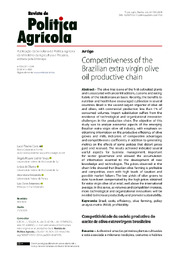Competitiveness of the Brazilian extra virgin olive oil productive chain.
Competitiveness of the Brazilian extra virgin olive oil productive chain.
Autoria: COSTA, L. T.; SOUZA, A. R. L. de; OLIVEIRA, L. de; FERNANDES, A. M; BELARMINO, L. C.
Resumo: The olive tree is one of the first cultivated plants and is associated with ancient traditions, customs and eating habits of the Mediterranean basin. Recently, the benefits to nutrition and health have encouraged cultivation in several countries. Brazil is the second largest importer of olive oil and olives, with commercial production less than 1% of consumed volumes. Import substitution suffers from the resistance of technological and organizational innovation challenges in the production chain. The objective of this study was to analyze economic aspects of the emerging Brazilian extra virgin olive oil industry, with emphasis on obtaining information on the productive efficiency of olive groves and mills, indicators of comparative advantages and competitiveness coefficients, in addition to generating metrics on the effects of some policies that distort prices paid and received. The results achieved indicated several useful aspects for business management, important for sector governance and allowed the accumulation of information essential to the development of new knowledge and technologies. The prices observed in the chain links showed that Brazilian olive farming is profitable and competitive, even with high levels of taxation and possible market failures. The low yields of olive groves to date have been compensated by the high prices obtained for extra virgin olive oil at retail, well above the international average. In this sense, as volumes and competition increase, more technological and organizational innovations will be needed to increase productivity and promote sustainability.
Ano de publicação: 2024
Tipo de publicação: Artigo de periódico
Unidade: Embrapa Clima Temperado
Palavras-chave: Azeite, Custo, Extra-virgin olive oil, Olive oil, Oliveira, Olivicultura, Profitability, Rentabilidade, Óleo Vegetal
Observações
1 - Por padrão são exibidas publicações dos últimos 20 anos. Para encontrar publicações mais antigas, configure o filtro ano de publicação, colocando o ano a partir do qual você deseja encontrar publicações. O filtro está na coluna da esquerda na busca acima.
2 - Para ler algumas publicações da Embrapa (apenas as que estão em formato ePub), é necessário ter, no celular ou computador, um desses softwares gratuitos. Sistemas Android: Google Play Livros; IOS: iBooks; Windows e Linux: software Calibre.
Acesse outras publicações
Acesse a Base de Dados da Pesquisa Agropecuária (BDPA) para consultar o acervo completo das bibliotecas da Embrapa.

